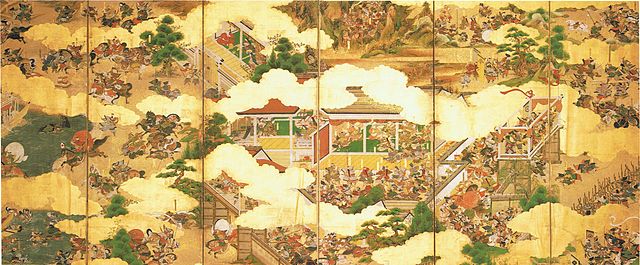Kumagai no Jirō Naozane was a famous soldier who served the Genji (Minamoto) clan during the Heian period of Japanese history. Kumagai is particularly known for his exploits during the Genpei War, specifically for killing the young warrior Taira no Atsumori at the battle of Ichi-no-tani in 1184. Later in life he became a Jōdo-shū Buddhist priest, as a disciple of Hōnen. Atsumori's death and the circumstances surrounding it went on to be fictionalized and retold in numerous forms, including the Heike Monogatari epic, a number of Noh plays, and in the jōruri and kabuki theatres as well.
Kumagai is often depicted riding his horse backwards. Though likely more myth than historical fact, he is said to have been determined to always face towards the Western Paradise of Amida, even when riding to the east, as part of his penance and devotion.
Ukiyo-e of Kumagai Naozane and Taira no Atsumori
The Genpei War was a national civil war between the Taira and Minamoto clans during the late Heian period of Japan. It resulted in the downfall of the Taira and the establishment of the Kamakura shogunate under Minamoto no Yoritomo, who appointed himself as Shōgun in 1192, governing Japan as a military dictator from the eastern city of Kamakura.
Scene of the Genpei War
The Heiji rebellion (1159) and the subsequent rise of the Taira were the main cause of the Genpei War 20 years later.
Scene of the Genpei war (1180–1185), Kanō Motonobu (1476–1569), Muromachi period (1336 and 1573).
The Phoenix Hall of the Byōdō-in, where Yorimasa committed seppuku






